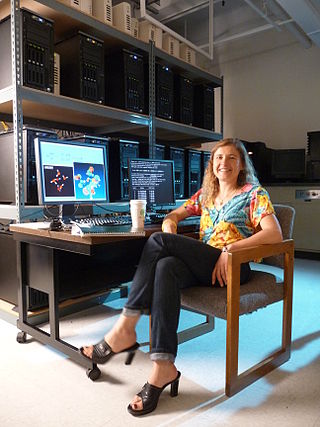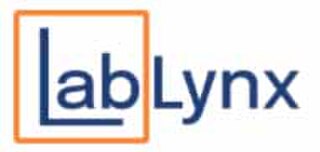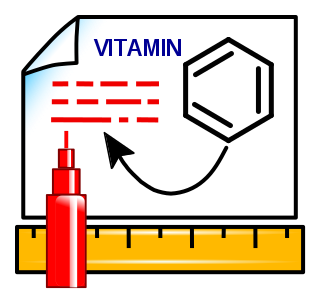Related Research Articles

Scientific visualization is an interdisciplinary branch of science concerned with the visualization of scientific phenomena. It is also considered a subset of computer graphics, a branch of computer science. The purpose of scientific visualization is to graphically illustrate scientific data to enable scientists to understand, illustrate, and glean insight from their data. Research into how people read and misread various types of visualizations is helping to determine what types and features of visualizations are most understandable and effective in conveying information.
Q-Chem is a general-purpose electronic structure package featuring a variety of established and new methods implemented using innovative algorithms that enable fast calculations of large systems on various computer architectures, from laptops and regular lab workstations to midsize clusters and HPCC, using density functional and wave-function based approaches. It offers an integrated graphical interface and input generator; a large selection of functionals and correlation methods, including methods for electronically excited states and open-shell systems; solvation models; and wave-function analysis tools. In addition to serving the computational chemistry community, Q-Chem also provides a versatile code development platform.
Amsterdam Density Functional (ADF) is a program for first-principles electronic structure calculations that makes use of density functional theory (DFT). ADF was first developed in the early seventies by the group of E. J. Baerends from the Vrije Universiteit in Amsterdam, and by the group of T. Ziegler from the University of Calgary. Nowadays many other academic groups are contributing to the software. Software for Chemistry & Materials (SCM), formerly known as Scientific Computing & Modelling is a spin-off company from the Baerends group. SCM has been coordinating the development and distribution of ADF since 1995. Together with the rise in popularity of DFT in the nineties, ADF has become a popular computational chemistry software package used in the industrial and academic research. ADF excels in spectroscopy, transition metals, and heavy elements problems. A periodic structure counterpart of ADF named BAND is available to study bulk crystals, polymers, and surfaces. The Amsterdam Modeling Suite has expanded beyond DFT since 2010, with the semi-empirical MOPAC code, the Quantum_ESPRESSO plane wave code, a density-functional based tight binding (DFTB) module, a reactive force field module ReaxFF, and an implementation of Klamt's COSMO-RS method, which also includes COSMO-SAC, UNIFAC, and QSPR.

OpenEye Scientific Software is an American software company founded by Anthony Nicholls in 1997. It develops large-scale molecular modelling applications and toolkits. Following OpenEye's acquisition by Cadence Design Systems for $500 million in September 2022, the company was rebranded to OpenEye Cadence Molecular Sciences and operates as a business unit under Cadence.
Open Babel is computer software, a chemical expert system mainly used to interconvert chemical file formats.

Spartan is a molecular modelling and computational chemistry application from Wavefunction. It contains code for molecular mechanics, semi-empirical methods, ab initio models, density functional models, post-Hartree–Fock models, and thermochemical recipes including G3(MP2) and T1. Quantum chemistry calculations in Spartan are powered by Q-Chem.
MDL Information Systems, Inc. was a provider of R&D informatics products for the life sciences and chemicals industries. The company was launched as a computer-aided drug design firm in January 1978 in Hayward, California. The company was acquired by Symyx Technologies, Inc. in 2007. Subsequently Accelrys merged with Symyx. The Accelrys name was retained for the combined company. In 2014 Accelrys was acquired by Dassault Systemes. The Accelrys business unit was renamed BIOVIA.

ISIS/Draw was a chemical structure drawing program developed by MDL Information Systems. It introduced a number of file formats for the storage of chemical information that have become industry standards.

ChemDraw is a molecule editor first developed in 1985 by David A. Evans, his wife Selena 'Sally' Evans, and Stewart Rubenstein. The company was sold to PerkinElmer in the year 2011. ChemDraw, along with Chem3D and ChemFinder, is part of the ChemOffice suite of programs and is available for Macintosh and Microsoft Windows.
BIOVIA is a software company headquartered in the United States, with representation in Europe and Asia. It provides software for chemical, materials and bioscience research for the pharmaceutical, biotechnology, consumer packaged goods, aerospace, energy and chemical industries.
Chemaxon is a cheminformatics and bioinformatics software development company, headquartered in Budapest with 250 employees. The company also has offices in Cambridge, San Diego, Basel and in Prague. and it has distributors in China, India, Japan, South Korea, Singapore, and Australia.

Anna I. Krylov is a Professor of Chemistry at the University of Southern California (USC), working in the field of theoretical and computational quantum chemistry. She is the inventor of the spin-flip method. Krylov is the president of Q-Chem, Inc. and an elected member of the International Academy of Quantum Molecular Science and the Academia Europaea.
Enthought, Inc. is a software company based in Austin, Texas, United States that develops scientific and analytic computing solutions using primarily the Python programming language. It is best known for the early development and maintenance of the SciPy library of mathematics, science, and engineering algorithms and for its Python for scientific computing distribution Enthought Canopy.

Antony John Williams is a British chemist and expert in the fields of both nuclear magnetic resonance (NMR) spectroscopy and cheminformatics at the United States Environmental Protection Agency. He is the founder of the ChemSpider website that was purchased by the Royal Society of Chemistry in May 2009. He is a science blogger and an author.

Chemicalize is an online platform for chemical calculations, search, and text processing. It is developed and owned by ChemAxon and offers various cheminformatics tools in freemium model: chemical property predictions, structure-based and text-based search, chemical text processing, and checking compounds with respect to national regulations of different countries.

LabLynx, Inc. is a privately owned, funded, and managed American corporation that develops, supports, and markets laboratory information management system (LIMS) solutions. Its primary offerings over the years have included webLIMS and ELab. The company’s primary clients include laboratories in the agriculture, clinical, environmental, forensics, health care, and manufacturing industries, including government agencies. The company is known for introducing one of the first browser-based LIMS products in 1997 and being in the laboratory informatics industry for decades.
Discovery Studio is a suite of software for simulating small molecule and macromolecule systems. It is developed and distributed by Dassault Systemes BIOVIA.
Dotmatics is an R&D scientific software company used by scientists in the R&D process that help them be more efficient in their efforts to innovate. Founded in 2005, the company's primary office is in Boston with 14 offices around the globe. In March 2021, Dotmatics joined forces with Insightful Science through a merger. In April 2022, the two companies consolidated under the Dotmatics brand. Dotmatics' software is used by 2 million scientists and researchers and 10,000 customers.

ACD/ChemSketch is a molecular modeling program used to create and modify images of chemical structures. Also, there is a software that allows molecules and molecular models displayed in two and three dimensions, to understand the structure of chemical bonds and the nature of the functional groups.

The Pittcon Heritage Award recognizes "outstanding individuals whose entrepreneurial careers shaped the instrumentation and laboratory supplies community." The award is jointly sponsored by the Pittsburgh Conference on Analytical Chemistry and Applied Spectroscopy (Pittcon) and the Science History Institute. The award is presented annually at a special ceremony during Pittcon.
References
- ↑ "Press Release".
- ↑ "Software review". Journal of Liquid Chromatography, Volume 15, Issue 14, 1992. via Taylor and Francis Online (subscription required)
- ↑ Review of chemistry drawing software. Laboratory Microcomputer, Volumes 12-13
- 1 2 Journal of the Association of Official Analytical Chemists. The Association. 1991. p. 714.
- ↑ Joyce, John "Pittcon 2006 Informatics Review" "Scientific Computing" Rockaway, NJ, April, 2006. Retrieved 14 November 2012.
- ↑ Johann Gasteiger; Thomas Engel (13 December 2006). Chemoinformatics: A Textbook. John Wiley & Sons. pp. 142–. ISBN 978-3-527-60650-4.
- ↑ Applied Spectroscopy. Society for Applied Spectroscopy. 1993.
- ↑ Larocque, Paul "Software to draw chemical structures (ChemWindow, by Softshell International Ltd.)", "Canadian Chemical News" Ottawa, June 1, 1996. Retrieved 14 November 2012.
- ↑ Robert G. Mortimer (1999). Mathematics for Physical Chemistry. Academic Press. pp. 362–. ISBN 978-0-12-508340-9.
- ↑ Günter Gauglitz; Tuan Vo-Dinh (6 March 2006). Handbook of Spectroscopy. John Wiley & Sons. pp. 1–. ISBN 978-3-527-60502-6.
- ↑ "KnowItAll 2021 & ChemWindow Maintenance Release Available!". Wiley Science Solutions. Retrieved 2021-10-28.
- Givan, Ray, "Quick on the Draw" "Scientific Computing World", Cambridge, UK, September, 2000.
- Joyce, John "Pittcon 2005 Informatics Review" "Scientific Computing" Rockaway, NJ, April, 2005. Retrieved 14 November 2012.
- Li, Z.; Wan, H.; Shi, Y.; Ouyang, P. (2004). "Personal Experience with Four Kinds of Chemical Structure Drawing Software: Review on ChemDraw, ChemWindow, ISIS/Draw, and ChemSketch". J. Chem. Inf. Comput. Sci. 44 (5): 1886–1890. doi:10.1021/ci049794h. PMID 15446849.